Return of the Weird
Jazz Age pulp authors H.P. Lovecraft and Robert E. Howard expose the alienation and paranoia of fin de millennium America better than the highbrow novelists of their age
By Zack Stentz
A PERFECTLY INTELLIGENT, well-respected man is going about his business, assured of his place in history, when suddenly he finds himself overwhelmed by an eerie sensation. Before he knows it, his body has been shanghaied, his mind cast into oblivion and his place taken by a mysterious alien entity that had been biding its time in a shadowy parallel dimension, waiting for just such an opportunity to strike and usurp his position.
If this sounds like a scenario out of a pulp horror/fantasy magazine of the 1920s and '30s, it should. But it describes equally well the strange transference that's taken place in our nation's popular culture, as the niches of popularity and influence once comfortably occupied by high-modernist literary authors like Ernest Hemingway and F. Scott Fitzgerald are getting inexorably hijacked by the lurid, undomesticated pulp writers of the same era.
While their more celebrated contemporaries spent the 1920s writing, screwing and drinking their way across the Left Bank of Paris, lesser-known American writers like H.P. Lovecraft and Robert E. Howard practiced their craft in prosaic locales like Providence, R.I., and Cross Plains, Texas. And though the former group gave between-the-wars America its preening superego, it was writers like Lovecraft (inventor of a sublimely creepy series of loosely linked horror stories and subject of a fascinating new biography by S.T. Joshi), Conan the Barbarian creator Howard (whose own life is chronicled in the new film The Whole Wide World) and their contemporaries toiling away in the wildly popular pulp magazines who provided the Jazz Age with its savage, tentacled id.
Writing for publications with names like Weird Tales, Thrilling Wonder Stories and Amazing Stories, Lovecraft and Howard eschewed the stark realism of the "serious" authors to spin outré tales of monsters, demons and swordsmen that even the writers themselves didn't think would outlive the cheap pulp paper on which they were printed.
But exhume this pair, now dead for six decades, reanimate them using an eldritch spell from one of their horror stories and take them on a stroll through the nearest bookstore past shelf upon shelf of volumes by and influenced by Howard and Lovecraft, and no one would be more surprised than they at the enduring popularity of their work.
And it's fitting that out of the dozens of writers working for the pulps of the era, most of whom--like Seabury Quinn, A. Merritt and E. Hoffmann Price--have faded into deserved obscurity, Lovecraft and Howard are the ones to be remembered and cherished.
Aside from being the best writers of the lot, Lovecraft, the gaunt, lantern-jawed New Englander, and Howard, the body-building Texan, were mutual admirers and close friends who, despite never meeting in person, carried on a lively correspondence. An annual award given to fantasy authors is actually called "The Howard" after both men (Howard is Lovecraft's first name), and the statuette is a caricature of Lovecraft's elongated Easter Island statue of a face, designed by Lovecraft fan and New Yorker cartoonist Gahan Wilson.
Of course, popularity is one matter and respect another, and certainly Howard and Lovecraft have a long way to go before being accepted into the canon of Major American Writers.
Let's put it this way: a student caught reading For Whom the Bell Tolls or The Great Gatsby during a high school English lecture would probably get a pat on the back and extra credit. But let the teacher spot that student perusing the pages of Howard's Conan the Cimmerian or Lovecraft's At the Mountains of Madness, and the young offender would likely end up in detention instead.
But though the former may remain the academics' darlings, it's the latter writers whose influence has waxed in this troubled, fin de millennium country of ours. The literary writers' legacy typically shows up in the Merchant-Ivory treatment of earnest, stultifying period films; Lovecraft and Howard's influence shines through in the far more vital mediums of action movies, rock songs and video games.
In the newest arbiter of contemporary cultural relevance, the Internet, one can search in vain for literary fictionoriented discussions, but newsgroups like alt.horror.cthulhu and alt.fantasy.conan carry numerous debates concerning various aspects of Lovecraft's and Howard's work.
More Weird Tales:
Many none too faithful (but often entertaining)
Cthulhu calls online with these Lovecraft
Richard von Busack's review of The Whole Wide World,
Lovecrafting the X-Files
THE WORK of Howard Phillips Lovecraft (18901937), in particular, with its themes of sanity-shattering alien entities and their twisted human accomplices plotting to subjugate the Earth, seems to strike a special chord with modern audiences.
"I don't see his popularity as having peaked," says Greg Stafford, founder and owner of the Oakland-based Chaosium publishing company, which puts out a well-regarded line of Lovecraftian books and games, available in the South Bay at any game or hobby store (an example can be seen on our cover). "If anything, Lovecraft is only becoming more popular."
Indeed, Chaosium's Lovecraft-based Mythos card game has proved so successful that the company recently doubled its work force from eight to 16 employees.
A dozen or more Web pages are also devoted to the author whose tales of cosmic alienation seem to resonate strongly with the denizens of cyberspace.
"I get over a hundred email messages a month from people asking about Lovecraft," says Donovan Loucks, a Phoenix-based database consultant whose own site, The H.P. Lovecraft Archive, is probably the best of the lot.
The number of Lovecraft-based and Lovecraft-influenced films need scarcely be mentioned (Re-Animator, The Evil Dead series and In the Mouth of Madness among them), and now video games have gotten in on the act as well, with the best-selling game Quake borrowing extensively from Lovecraft's bestiary of imaginary monsters to stock its electronic dungeon.
The idea of a shoot-'em-up computer game based on Lovecraft's stories seems especially comic given the author's own professed distaste for games ("Games and sports should not be considered among the major phenomena of life," he once wrote to Robert E. Howard) and when considering how little action his stories contain.
The typical Lovecraft scenario involves a mild-mannered New England intellectual stumbling upon a strange occurrence that eventually leads him to some mind-shattering confrontation with alien entities bent on returning from extradimensional exile to enslave the Earth. In a truly Lovecraftian video game, players would probably spend most of their time in a library, poring over many a quaint and curious volume of forgotten lore, then go insane and jump out a window at the sight of the first monster.
On TV, that zeitgeist-tapping program of the '90s, The X-Files, bears the unmistakable stamp of Lovecraft upon it like the mark of Cain or the "Innsmouth look" of "The Shadow over Innsmouth," complete with bloodthirsty cults, rural degenerates, sanity-destroying horrors and overall vision of humanity as unknowing puppets of malign alien influences. The X-Files also shares Lovecraft's device (innovative in its time) of setting a series of otherwise unrelated stories against a fully developed artificial mythology with an internally consistent set of references.
In particular, Fox Mulder's New England patrician origins, strange phobias and warped, stunted sexuality make him a very Lovecraftian protagonist, though the FBI agent's dogged pursuit of knowledge is out of keeping with Lovecraft's assertion that some facts are better left not pondered by human minds.
Compare The X-Files' famous catch phrase, "The Truth is out there," with Lovecraft's statement that opens "The Call of Cthulhu": "The most merciful thing in the world, I think, is the inability of the human mind to correlate all its contents. We live on a placid island of ignorance in the midst of black seas of infinity, and it was not meant that we should voyage far."
The Truth may indeed be out there, Lovecraft's fiction seems to say, but far from setting us free, it threatens to drive us mad or send us screaming back to the comfort of a new Dark Age. (Or a dark New Age, as the case may be. With their harmonic convergences, alien contacts, magic crystals and babblings of ancient prophecies, much New Age literature comes across as a bad Lovecraft parody.)
'COME FOR THE monsters, stay for the ideas," would be the phrase that best describes Lovecraft's enduring appeal to successive generations of readers. It's certainly true that many readers are initially drawn to Lovecraft by his detailed descriptions of convincingly alien aliens. From icthyic Deep Ones and star-headed Old Ones to crustaceous fungi from Yuggoth, no one did aliens like Lovecraft, and H.R. Giger's biomechanical/sexual designs for Species and Alien show his influence clearly.
But it's the philosophical vision shining through the horror-story trappings that puts Lovecraft's writing above the ranks of his pulp contemporaries and makes him resonate so strongly in our own time.
Biographer S.T. Joshi and others refer to this vision as "cosmic indifferentism," the notion that humanity occupies an insignificant place in the overall workings of the universe.
"Lovecraft lived in a time when the scientific discoveries of the day--Einstein's general and special theories of relativity, and the astronomers placing earth out toward the edge rather than the center of the galaxy--were steadily diminishing humanity's place and importance in the Universe," says Chaosium's Lynn Willis, who helped design many scenarios for the Call of Cthulhu role-playing game based on Lovecraft's fiction.
Stafford, Willis and fellow game designers Shannon Appel and Charlie Krank (both South Bay natives) have the intellectually focused, slightly unkempt look one typically associates with computer jocks, but they wax as eloquent as grad students when discussing the author from whose work they derive their livings, often referring to him as "Howard," as if he were a beloved old friend sitting in the next room. Along one wall, shelves of Chaosium's games in French, German, Spanish and Japanese attest to Lovecraft's global popularity.
"And this diminishment and sense that humanity and the Earth are simply not very important in the greater scheme of things has only become more accepted in our age," Willis says.
"Look at the world we live in," Krank says. "There's very much a sense that we're the victims of powers much larger than us. I mean, what is a billion dollars? You can't even get your mind around it."
With protagonists plotted against by malign conspiracies, holding a tenuous grip on sanity, and mocked, tormented and discarded by the gods themselves, stripped of their science-fiction and supernatural trappings, Lovecraft's stories provide a reasonably accurate description of life on late-20th-century Earth.
And yet, amid the unremitting bleakness do burn a few flickers of hope. "My theory about why 'The Call of Cthulhu' and Lovecraft's fiction resonate so strongly with people," Stafford says, "is that despite being set in an arbitrary, impersonal, cruel universe, they show that small, individual acts of dignity and goodness are possible."
The world view Stafford has described, of course, matches closely a philosophy put forward in the 1920s and '30s in France and the United States, a fact not lost on Willis. "It's very existential," he acknowledges, and a surprising number of literary heavyweights agree (among them Jean Cocteau, Jorge Luis Borges and Umberto Eco), looking beyond the moldering settings and unpronounceable names of Lovecraft's fiction to see a writer wrestling with the serious topic of humanity's place in an uncaring universe. Borges, in his maddeningly elliptical way, first denied ever having heard of Lovecraft--then went on to dedicate his story "There Are More Things" to him.
And really, which writer communicates that concept of our insignificance in the cosmic scale--a central motif of 20th-century literature--in a more effective and entertaining manner? Contrast Hemingway at the end of "A Clean, Well-Lighted Place," with his whiny little "Our nada who art in nada" nihilist Lord's Prayer parody, and the climactic scene in Lovecraft's final and arguably greatest story, "The Shadow Out of Time."
Lovecraft's narrator describes finding a book in the library of a long-extinct race of beings who he believes once telepathically exchanged minds with him. "No eye had seen, no hand had touched that book since the advent of man to this planet. And yet ... I saw that the queerly pigmented letters on the brittle, aeons-browned cellulose pages were not indeed any nameless hieroglyphs from Earth's youth. They were, instead, the letters of our own familiar alphabet, spelling out the words of the English language in my own handwriting."
GRIPPING STUFF, to be sure, but is it literature? Joshi certainly makes the case for Lovecraft's inclusion in the literary canon and points out that, contrary to legendary literary critic Edmund Wilson's famous "hack-work" slam against Lovecraft in a 1945 New Yorker review, Lovecraft's fiction was written with a care and sincerity of purpose that transcended the pulpy medium in which it appeared.
"Lovecraft was a perfectionist who wrote more for himself than for the pulp audience," Appel says. "And it's quite instructive to read his assessments of the other pulp writers. He could be merciless."
"He ... probably thinks Santayana is a brand of coffee," Lovecraft wrote of close friend Robert E. Howard, though of the Texan's writing he averred, "He has a set of emotions which he has molded and directed in uniquely harmonious patterns ... pictures which insist on remaining distinctive and self-expressive despite all outward concessions to the stultifying pulp ideal."
Howard, for his part, thought Lovecraft too civilized and sheltered from the outside world, and the two men carried on a sometimes raucous debate over the relative merits of civilization and barbarism.
In contrast to Howard's tales of rough-and-ready barbarians, Lovecraft's heroes are all scholarly city dwellers. In his fiction, the countryside isn't a source of vigor and renewal but a benighted place of inbreeding, cannibalism and extradimensional entities stalking the forests and lonely hillsides.
Standing between Lovecraft's literary respectability, like Great Cthulhu himself (the cyclopean, squid-headed alien deity of "The Call of Cthulhu"), is what one might delicately call the language problem. Namely, the easily parodied, adjective-rich prose style that Lovecraft developed under the influence of his hero Edgar Allan Poe and British fantasists Arthur Machen and Lord Dunsany. Already somewhat archaic in his own day, his writing, long on atmosphere, short on plot and characterization, looks even more unwieldy in an age that worships action and dialogue, and whose primary literary form is the screenplay.
"And yet I saw them in a limitless stream--flopping, hopping, croaking, bleating--surging inhumanly through the spectral moonlight in a grotesque, malignant saraband of fantastic nightmare," Lovecraft writes in "The Shadow Over Innsmouth," which, despite its Poe-derived abundance of modifiers, is actually a model of restraint by Lovecraft's standards.
Lovecraft also shared with Poe an aversion toward grounding his fiction in the manners and mores of the era he lived in. Just as one searches Poe's fiction in vain for references to Emerson or the Abolitionists, the works of Lovecraft seem scarcely set in the same world as Babe Ruth, Prohibition or the rise of European fascism.
The same could be said for Lovecraft the man, an antiquarian who derived much of his life's pleasure from the colonial architecture of his native Providence and who dressed in archaic, detachable-collared suits long after the soft collar had won the day.
But what seemed like a myopic refusal to ground his fiction in the temper of the time actually makes Lovecraft's stories more readable to modern audiences not familiar with the cultural landmarks of the 1920s. "We shall never know, or never care, what Edgar Allan Poe thought of Andy Jackson's kitchen cabinet or how H.P. Lovecraft regarded the Teapot Dome scandal," Lovecraft correspondent and protégé Robert Bloch--a well-regarded horror/science fiction author in his own right, best known for writing Psycho--commented in one essay.
Toward the end of his career, Lovecraft himself seemed to be tiring of his over-the-top prose, which began changing color from deep indigo to merely bluish. Late stories like "The Haunter of the Dark" and "The Shadow Out of Time" reveal a steady paring-down of superfluous description, along with a deepening and maturing of his vision of "cosmic awe," making Lovecraft's untimely 1937 death from intestinal cancer at age 46 all the more tragic. Lovecraft's own story ends very much in the middle, and his greatest work may very well have lain in front of him.
"And whether or not what he wrote was literature," Loucks asserts, "Lovecraft was a literary individual, and you see that very clearly in his letters."
One of the last great American correspondents, Lovecraft wrote more than 100,000 letters--some up to 60 pages long--throughout his lifetime to friends, family and fans, the missives bristling with the contemporary references, warmth and self-knowledge sometimes missing from his fiction.
Joshi defends Lovecraft from critics who have questioned the author's seemingly wasteful practice of spending three to five hours a day corresponding with friends and politely answering every piece of fan mail, no matter how banal, by pointing out that letters were Lovecraft's primary social and intellectual outlet. And some of these gushing young fans, among them James Blish, Fritz Leiber and Robert Bloch, would go on to become major science fiction, fantasy and horror writers, and would cite Lovecraft's thoughtful letters as major sources of inspiration.
To Joshi's credit, he doesn't shy away from the more prickly, unpleasant aspects of Lovecraft that the letters often display (much as H.L. Mencken's letters revealed his many warts), from his stubborn refusal to engage in the world of commerce by promoting his own work (which, as a self-styled 18th-century "gentleman," he found mercenary and unbecoming), to his sometimes virulent racism and anti-Semitism.
To be fair, though, Lovecraft's views changed and mellowed concurrent with the improvement in his fictional prose, as he evolved from a racist, right-wing extremist ("The Negro is fundamentally the biologically inferior of all White and even Mongolian races," Lovecraft wrote in 1915, voicing an opinion then depressingly common) to a New Dealbacking moderate socialist.
And even during the period when Lovecraft's letters spewed the most bigotry and misanthropy (the early to mid-1920s, according to Joshi, when Lovecraft, bitter over his inability to find a job or become a literary success while living with his wife, Sonia Greene, in New York, made Ambrose Bierce look like Norman Vincent Peale), the man himself was by all accounts unfailingly courteous and kind to his fellow humans, and at one point was amicably married to Greene, a Jewish woman.
The issues that drove the pair to divorce seemed to be related more to Lovecraft's financial ineptness, emotional inexpressiveness and near-nonexistent sex drive (his racy surname aside, Greene famously referred to him as "an adequately excellent lover") than to any of his prejudices.
And despite earlier biographer L. Sprague De Camp's half-baked posthumous psychoanalysis and speculations as to Lovecraft's true sexual nature, all evidence suggests that Lovecraft disliked homosexuals as well, all the while blissfully unaware that many of his closest friends and acquaintances, among them Samuel Loveman, Robert Barlow and poet Hart Crane, were gay.
In another improvement on De Camp, Joshi also refrains from tiresome Freudian readings of Lovecraft's relationship with his admittedly strange family, contenting himself with presenting the facts and letting the readers draw conclusions from them. (Lovecraft's father died of syphilis-induced insanity when his only son was a child, while his mother simultaneously indulged and belittled the future author.)
More than the facts of his life and family, it's the contradiction between vicious stated views and unfailingly decent private behavior--the mirror image of Picasso painting Guernica while abusing his friends and mistresses--that makes Lovecraft such a fascinating biographical subject and his letters so readable.
Joshi goes so far as to claim that in the future, Lovecraft's letters, not his stories, may come to be regarded as his major literary achievement, as with author Henry Walpole, whose letters are read and studied, though his novel, The Castle of Otranto, has faded into near-oblivion.
IN THE END, though, it's impossible to separate the high-minded Lovecraft, who, despite never completing high school, wrote knowledgeably about Spengler, Freud, Einstein and Schopenhauer to his friends, from the author of stories with titles like "The Dunwich Horror" and "The Thing on the Doorstep."
Efforts of biographers like Joshi and fans like Loucks to dismiss the ancient books, decaying cities and tentacled horrors of Lovecraft's stories--often but erroneously referred to as the "Cthulhu Mythos"--as immaterial to the deeper themes of Lovecraft's fiction come off as ridiculously high-minded, like Vladimir Nabokov asserting that emotional identification with fictional characters is silly and juvenile.
And it's clear that for some fans, those "superficial" trappings are what excite them. Fantasy author Neil Gaiman relates in his introduction to a recent Lovecraft story collection an anecdote from a fantasy/horror convention where the speakers took turns describing the deep psychological reasons behind their love of Lovecraft.
"Fuck all that," interrupted panelist Dave Carson, a rather drunken English comic and book-jacket illustrator. "I love H.P. Lovecraft because I just like drawing monsters."
In Lovecraft's very best stories, big ideas and crowd-pleasing entertainment rub elbows comfortably, as in "The Shadow out of Time" or At the Mountains of Madness, in which horrific aliens turn out to be merely the inquisitive scientists of their own age and species, not so different from us after all.
And does it really matter, in the greater scheme of things, if Lovecraft is accepted into the canon of serious literary authors where his fans think he belongs? In an age when the books of many of our respected literary novelists languish on library shelves, as little-seen as the Necronomicon, Lovecraft's fictional book of accursed spells and legends, Lovecraft's own work (and Howard's as well) remains read and enjoyed by millions worldwide, influences the writing of other authors, and is the object of much scholarly study and commentary.
This state of affairs would have gratified to no end the man who once wrote (through his spokesman, Necronomicon author Abdul Alhazred): "That is not dead which can eternal lie/And with strange aeons, even death may die."
"In one sense, I do hope Lovecraft's work is accepted as literature, because I hope my great-grandchildren will have the chance to find and enjoy his work," Loucks says. "But in another sense, I really don't care if he's accepted or not. I already read him."
[ Metro | Metroactive Central | Archives ]
This page was designed and created by the Boulevards team.
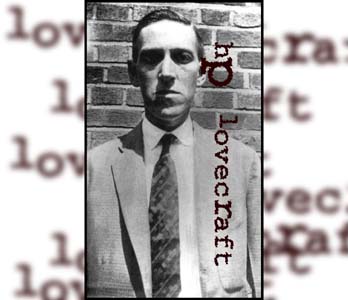
Alt.Horror.Lovecraft: Lantern-jawed new England author H.P. Lovecraft created a world full of nameless dread and ancient, lurking terrors.![[line]](/gifs/line.gif)
films have been based on the works of both Howards.
and Howard related web sites.
the new bio-pic of Robert E. Howard.![[line]](/gifs/line.gif)
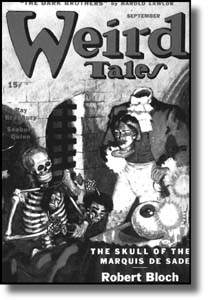 Lilliputian Complex
Lilliputian Complex
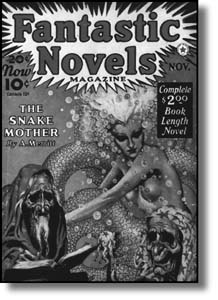 Pen Palaverous
Pen Palaverous
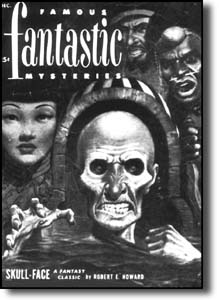
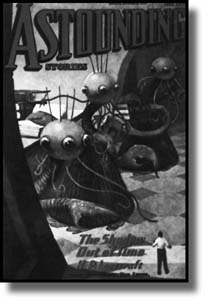 Monster Match
Monster Match
H.P. Lovecraft: A Life by S.T. Joshi; Necronomicon Press, West Warwick, R.I.; 704 pages, $20.00 paper
From the January 2-8, 1997 issue of Metro
Copyright © 1997 Metro Publishing, Inc.
![[Metroactive Books]](/books/gifs/books468.gif)